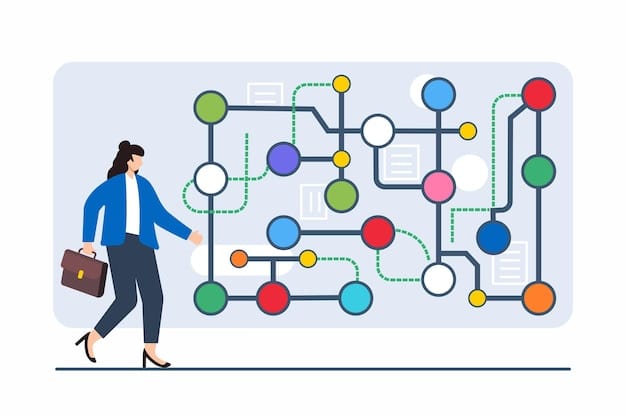Boost Customer Lifetime Value: Proven Retention Strategies for 20% Growth

Improving Customer Lifetime Value (CLTV) involves implementing strategic approaches focused on enhancing customer retention and fostering loyalty, ultimately aiming for a quantifiable increase of 20% in the value a customer brings to a business throughout their relationship.
Are you looking to boost your bottom line? Improving Customer Lifetime Value: Strategies for Increasing Retention and Loyalty by 20% is the key. By focusing on customer retention and loyalty, businesses can significantly increase the revenue generated from each customer over their entire relationship with the company.
Understanding Customer Lifetime Value (CLTV)
Customer Lifetime Value (CLTV) is a crucial metric that predicts the total revenue a business can expect from a single customer throughout their entire relationship. It’s not just about the immediate purchase; it’s about the long-term value that a loyal customer brings to your business.
Understanding CLTV helps businesses make informed decisions about customer acquisition, retention, and marketing strategies. By knowing how much a customer is worth over time, companies can prioritize their efforts and allocate resources effectively.
Why CLTV Matters
- Better Resource Allocation: CLTV helps you understand where to invest your resources for maximum impact.
- Improved Customer Retention: By focusing on increasing CLTV, you naturally improve customer retention rates.
- Enhanced Profitability: Loyal customers are more likely to make repeat purchases and recommend your business to others.
Calculating CLTV involves analyzing various factors such as average purchase value, purchase frequency, and customer lifespan. While there are different formulas, the core principle remains the same: to estimate the total revenue a customer will generate.
Ultimately, understanding and optimizing CLTV can lead to sustainable growth and a stronger competitive advantage. Businesses that prioritize long-term customer relationships are more likely to thrive in today’s dynamic market.

In conclusion, understanding Customer Lifetime Value is fundamental for strategic decision-making, resource allocation, and fostering long-term customer loyalty, which collectively contribute to enhanced profitability and sustainable business growth.
Strategies to Enhance Customer Retention
Customer retention is the cornerstone of improving Customer Lifetime Value because it directly impacts the length and profitability of your relationship with your customers. Effective retention strategies ensure that customers remain engaged and loyal to your brand.
Implementing strategies such as loyalty programs, personalized experiences, and proactive customer service can significantly enhance customer retention rates, contributing to a higher CLTV. Let’s explore some of these strategies in detail.
Loyalty Programs
Loyalty programs are a great way to reward repeat customers and encourage them to stay with your brand. These programs can range from simple points-based systems to tiered memberships with exclusive benefits.
Effective loyalty programs offer tangible value to customers, making them feel appreciated and incentivized to continue doing business with you. They also provide valuable data on customer behavior and preferences, which can be used to further personalize the customer experience.
Personalized Experiences
Personalization is all about tailoring the customer experience to meet the unique needs and preferences of each individual. This can include personalized product recommendations, targeted marketing messages, and customized customer service interactions.
- Data Analysis: Use data to understand customer behavior and preferences.
- Targeted Marketing: Send personalized marketing messages based on customer interests.
- Customized Service: Tailor customer service interactions to individual needs.
By personalizing the customer experience, businesses can create stronger connections with their customers, fostering loyalty and increasing CLTV. The key is to use data and insights to deliver relevant and valuable experiences at every touchpoint.
To summarize, enhancing customer retention hinges on implementing well-designed loyalty programs and delivering personalized experiences, each playing a vital role in fostering lasting customer relationships and maximizing Customer Lifetime Value.
The Role of Customer Experience in CLTV
Customer Experience (CX) plays a vital role in shaping customer perceptions, fostering loyalty, and ultimately driving Customer Lifetime Value. Every interaction a customer has with your business, from browsing your website to contacting customer service, contributes to their overall experience.
A positive customer experience can lead to increased satisfaction, loyalty, and advocacy, while a negative experience can result in churn and lost revenue. Therefore, it’s essential to prioritize CX and continuously strive to improve every aspect of the customer journey.

Key Elements of a Positive Customer Experience
- Ease of Use: Make it easy for customers to find what they need and complete their tasks.
- Responsiveness: Respond promptly to customer inquiries and resolve issues quickly.
- Empathy: Show understanding and compassion for customer needs and concerns.
By focusing on these key elements, businesses can create a customer experience that is both satisfying and memorable, leading to increased loyalty and CLTV. It’s also important to continuously gather feedback and use it to improve the customer journey.
Customer Experience significantly impacts Customer Lifetime Value by influencing the likelihood of repeat business and positive word-of-mouth, making it imperative for organizations to prioritize and continuously improve every touchpoint in the customer journey.
Leveraging Customer Feedback for CLTV Improvement
Customer feedback is an invaluable resource for businesses looking to improve Customer Lifetime Value. By actively soliciting and listening to customer feedback, companies can gain insights into what they’re doing well and where they need to improve.
Feedback can come in many forms, including surveys, reviews, social media comments, and direct communication with customer service. The key is to have systems in place to collect, analyze, and act on this feedback effectively.
Methods for Collecting Customer Feedback
- Surveys: Use surveys to gather structured feedback on specific aspects of the customer experience.
- Reviews: Monitor online reviews to understand what customers are saying about your business.
- Social Media: Engage with customers on social media to gather informal feedback and address concerns.
Once you’ve collected customer feedback, it’s important to analyze it to identify trends and patterns. This can help you prioritize areas for improvement and make data-driven decisions about your customer experience strategies.
In summary, leveraging customer feedback is crucial for continuous improvement in Customer Lifetime Value, providing actionable insights to enhance products, services, and the overall customer journey.
The Impact of Personalization on Customer Loyalty
Personalization goes beyond simply addressing customers by name; it involves tailoring the entire customer experience to meet their unique needs and preferences. This includes personalized product recommendations, targeted marketing messages, and customized customer service interactions.
When customers feel understood and valued, they’re more likely to develop a sense of loyalty to your brand. This loyalty translates into repeat purchases, positive word-of-mouth referrals, and increased Customer Lifetime Value.
Benefits of Personalization
- Increased Engagement: Personalized experiences are more engaging and relevant to customers.
- Improved Loyalty: Customers are more likely to remain loyal to brands that personalize their experiences.
- Higher CLTV: Loyal customers generate more revenue over their lifetime.
To effectively personalize the customer experience, businesses need to collect and analyze data on customer behavior and preferences. This data can be used to create personalized profiles and deliver targeted experiences at every touchpoint.
Ultimately, the impact of personalization on customer loyalty underscores the importance of understanding individual customer needs, preferences, and behaviors, fostering deeper connections and driving long-term Customer Lifetime Value.
Measuring and Tracking CLTV Improvement
Measuring and tracking CLTV improvement is essential for understanding the effectiveness of your retention and loyalty strategies. By monitoring key metrics, you can identify what’s working, what’s not, and make data-driven adjustments to your approach.
There are several different ways to calculate CLTV, but the most important thing is to choose a method that is relevant to your business and consistently track it over time. This will allow you to see trends and patterns and assess the impact of your efforts.
Key Metrics to Track
Here are some key metrics to track when measuring CLTV improvement:
- Customer Retention Rate: The percentage of customers who remain with your business over a given period.
- Average Purchase Value: The average amount that customers spend on each purchase.
- Purchase Frequency: How often customers make purchases.
By tracking these metrics and analyzing the data, businesses can gain valuable insights into customer behavior and preferences. This information can be used to refine your retention and loyalty strategies and drive further improvements in CLTV.
In conclusion, measuring and tracking CLTV improvement is essential for evaluating the effectiveness of customer retention strategies, providing concrete data for informed decision-making and continuous optimization.
| Key Point | Brief Description |
|---|---|
| 📈 Understanding CLTV | Knowing CLTV helps in resource allocation and retention strategies. |
| ❤️ Loyalty Programs | Rewarding customers boosts loyalty and repeat business. |
| 🗣️ Customer Feedback | Listening to feedback improves products and services. |
| 🎯 Personalization | Tailoring experiences increases engagement and loyalty. |
Frequently Asked Questions
▼
Customer Lifetime Value (CLTV) predicts the total revenue a business can expect from a single customer throughout their entire relationship reflecting their long-term value.
▼
Loyalty programs reward repeat customers, encouraging them to stay with the brand and make repeat purchases, thus increasing their lifetime value.
▼
Positive customer experiences lead to increased satisfaction and loyalty, directly impacting the length and profitability of the customer relationship.
▼
Personalization makes customers feel understood and valued, fostering loyalty and increasing the likelihood of repeat business and positive word-of-mouth.
▼
Key metrics include customer retention rate, average purchase value, and purchase frequency, providing insights into customer behavior and preferences.
Conclusion
In conclusion, improving Customer Lifetime Value: Strategies for Increasing Retention and Loyalty by 20% involves a multifaceted approach that prioritizes customer experience, leverages feedback, and personalizes interactions. By focusing on these strategies, businesses can foster long-term loyalty and significantly increase the value each customer brings to the company.





